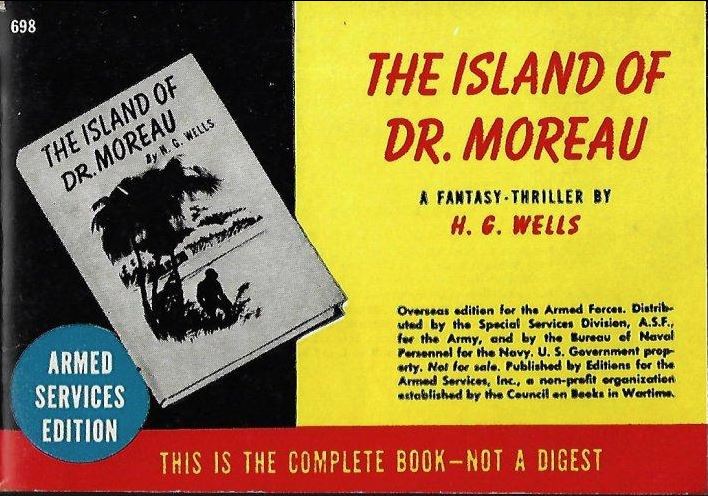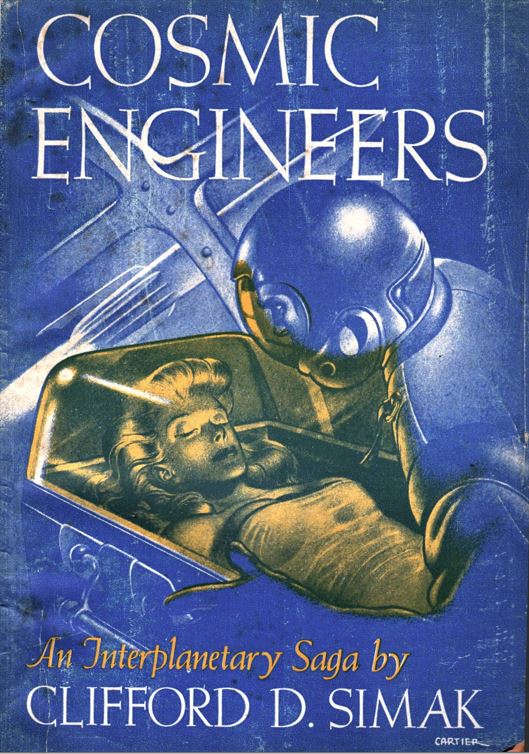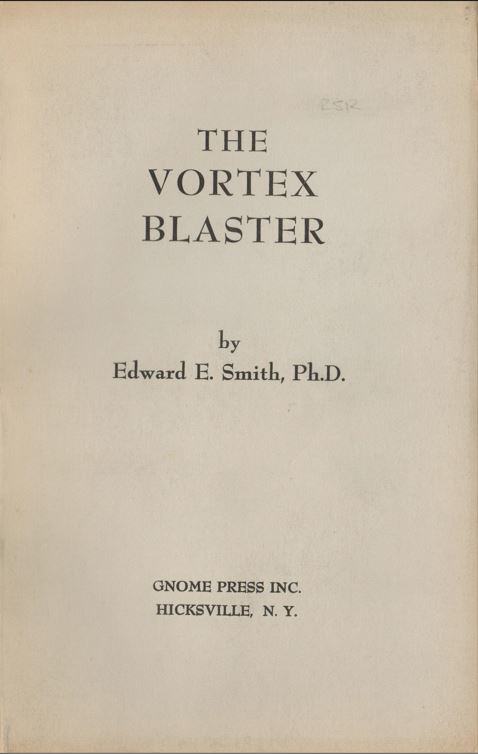Not a digression, but a needed bit of history. From 1943 to 1946 the Council on Books in Wartime printed an astounding 123,000,000 copies of 1,227 titles to distribute free reading material to U.S. troops. These Armed Services Editions (ASE) were cheaply printed but highly valued. They were, in fact, often read to death. In order to make them available to many readers simultaneously, the first reader would tear off a chapter upon finishing it and hand it to a second reader, who would pass it along to a third upon receiving the second chapter and so on. Whole copies didn’t have much longer lives. Most soldiers didn’t consider the books worth hauling back to America from halfway around the world. Today the rarity of these books builds upon their fragility to make them collectible, with a full set beyond dreams. It’s possible that the Library of Congress has the only complete set, although a few university collections are close. The completist mania of science fiction fans makes the tiny number of titles that have a connection to the field – The Time Machine, Dracula, Tarzan – among the most expensive. No contemporary f&sf authors were ever published, not surprising since virtually no titles existed to be reprinted.
Only a few years later the U.S. was back at war, in Korea. Hundreds of thousands of soldiers once again needed books. As the story goes, Greenberg saw a market. Already printed pages from George O. Smith’s Pattern for Conquest, Clifford D. Simak’s Cosmic Engineers, Isaac Asimov’s I, Robot, and Nelson Bond’s The Thirty-First of February were bound with plain white paper that had the front covers of the books reproduced on them, with bare print on the spine and a blank rear. The books were sent to Korea as part of the new ASE project.
CHALKER says of them:
Pattern for Conquest. 5000 copies, printed; 2000 bound as trade paperbacks for Armed Forces. … Currey states Armed forces is a reprinting; Greenberg and Kyle at various times have maintained it was a 1952 binding of leftover sheets printed with the first in 1949, and physical examination shows no differences even in paper.
The Thirty-First of February. 5000 copies printed, of which half were hardbound on printing, the rest paperbound in trade format for Armed Forces distribution a year or so later at $1.00.
I, Robot. 5000 copies printed hardbound; 2500 additional copies were bound in 1951 as trade paperback “Armed Forces Edition.”
Cosmic Engineers. 6000 copies printed, of which 1000 were bound as trade pb “Armed Forces Edition.”
Except… Not a word of this appears to be true other than the claim these were a reprinting. No ASE were printed for the Korean War. I’ve seen no evidence that any formal book program was ever created, nor that publishers voluntarily sent books over. The format of these trade paperbacks doesn’t conform to the strictures of the originals, which were designed to be lightweight, on thin paper, and small enough to fit into a pocket. All ASE books were given away free; it’s conceivable that books could be have been produced to sell at commissaries, but regular paperbacks were already small and portable and only cost 25¢ (until paper restrictions drove prices to 35¢ by the end of the war).
Physical examination shows that the paper used bears no resemblance to the paper used in the Gnome hardcovers, a higher-grade paper that remains white today as opposed to the uniform brown of the paperbacks. They also show all signs of being produced as a set: they are essentially the same size (although February is a skootch bigger), smaller than any of the original hardcovers, have the same paper, and the same thickness. The trades are far thinner than the hardbacks, a mere 0.5-0.6”. Text blocks of the originals are a full 0.9”-0.1” thinner. The covers are not the original dust jackets cut to size; the full artwork of the originals was proportionately reduced to fit, so they must have been specially produced. Yet the type is set with slightly more leading between the lines so that it covers more of the pages; a barely noticeable 0.1”, true, but the ruler confirms what the eye sees. CURREY undoubtedly correctly refers to all four as reprintings, dating I, Robot as c1951, and delegating the other three to c1952. I don’t know what he based those dates on.
My guess is that the trades were an experiment to test the market, released without permanent pricing to see what the proper price point would be. That’s the only thing that explains KEMP’s comments.
Pattern for Conquest. Identical Armed Services edition, 2,000 copies bound sold for .35¢. [sic] … (This is an unusual edition, this reader has seen copies with a .50¢ and .60¢ [sic] price on the front cover, knocked out in a small white square on the front cover….)
The Thirty-first of February. 1,000 copies bound sold for .35¢. [sic]
I, Robot. 1,000 copies bound sold for 35¢.
[Cosmic Engineers. No prices given.]
Years of scouring the internet have failed to bring up a single copy or image of any of the four labeled with any price. Examples with a labeled price would rank high among the rarest Gnome items and command huge amounts; unless they are being zealously hoarded in secret why such never come to market if they exist is as mysterious as everything else about these books. Even the unpriced copies are much scarcer than the purported number printed would indicate. Less than a half dozen can be found on the internet at any given time. As this is being written in 2023, only two are listed, both of Pattern.
(Searches may find the copies listed as in “wrappers” or “wraps.” All paper-covered book editions are technically known as in wrappers. You can refer to any mass-market or trade paperback that way, but their covers are usually of stiffer or thicker paper than the thin paper on the Gnome editions. Dust wrapper as a synonym for dust jacket is sometimes seen but shouldn’t be confused with softbound editions. Yes, book collecting is often a mess even outside of Gnome.)
Another common story is that Nelson Bond heard about the paperback edition of his book, but not from Greenberg. Since he never received any royalties from their sales, he got the remaining copies in lieu of payment and sold them through his bookstore, which explains why they are easier to find than the others.
The first sentence is in fact true. I happened to be at the 1998 Nebula Award ceremonies, at which Bond was being honored as that year’s Author Emeritus. I took my copies of February to be signed and his eyes lit up at the paperback, something he had not seen in years. He confirmed the confrontation with Greenberg.
The second sentence is far iffier. Bond did run a bookstore – but not until 1965, long after Greenberg lost possession of physical copies of any of the books. In the early 1950s, Bond was a busy working writer, splitting time between Virginia and Hollywood. Running a bookstore wouldn’t fit into that schedule, even besides the lack of mention of one in his biographies. Nor are copies of February appreciably more available than the others, with appearances always in the low single digits. Bond’s grab of the remaining copies also calls into question their being ASE. If so, wouldn’t all the stock have been shipped overseas and not be sitting in boxes in Gnome’s storeroom? To be fair, Bond’s inscription on the copy I have states: “This Armed Services edition: my contribution to America’s war effort.” Perhaps Greenberg intended them for a new round of ASEs only to find that no organized program was starting. Yet Bond claimed he wasn’t told of the printing until he stumbled across them and by then their fate had to be obviously not for Korea. Far more likely that the books appeared, at some price, in some select bookstore, where they could be spotted and reported.
Yet this explanation contains its own huge flaw. Nobody seemed to have spotted or reported them. A search through all online period fanzines and professional magazines fails to uncover a single mention of such a trade paperback edition or ASE. No books for Korea program is part of the discourse either. The scanned fanzines available online are a small fraction of the total, to be sure, but such a major event should have been widely covered. No rational existing evidence explains their physical presence in the world.
A footnote to the above is that a later trade paperback does exist and have an explanation. As told in The History of Gnome, Greenberg was drowning in debt, much of it due to the warehousing costs he needed to pay for the thousands of unbound copies of unsold books stored with his printer. According to CHALKER, he did an experimental binding of a small number of copies of Edward E. Smith’s The Vortex Blaster, possibly as few as six, with the thought of selling them at a deeply discounted price through his PICK-A-BOOK catalog.
The extant copies resemble a minimalistic Advance Reading Copy, with the cover a plain gray under black type, with the spine and back cover blank. It’s not known if this style was to be used for sale or whether the book jacket cover would be copied as on the earlier paperbacks. One substantial difference is that this was a true rebinding, since the original paper and size have been retained.
Another more fatal difference is that rather than be a cheap alternative to $3.00 hardcovers, any 1960s trade paperback would be competing with Greenberg’s own PICK-A-BOOK offerings, which gave buyers the original hardbacks for as low as $1.20 each when ordering ten. Apparently, the economics of distributing an unattractive, manifestly cheap product for marginally less didn’t make more sense than any of his other schemes. However many copies were bound, let’s say six, none ever made it out the door.
Six copies. Six never sold or distributed experimental internal copies. You’d think that these would be rarer than hundred-caret diamonds, not merely the hardest-to-find and priciest of all Gnome Press items, but of all the million items in the science fiction field. Assuming that they still existed at all! Yet back in 2015 not one, but two copies of this scarcest of all Gnome Press titles popped up in an online search, being sold by two different dealers. By 2019 a dealer had managed to gather three. He wanted to corner the field and knew of at least one he didn’t own. That one was mine. I politely but firmly declined. Anyone out there who would care to admit owning any of the others should contact me. Together we’d make up one of the world’s most exclusive clubs.







